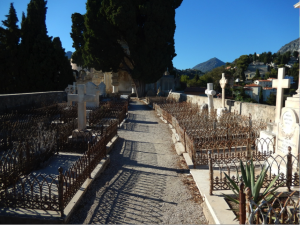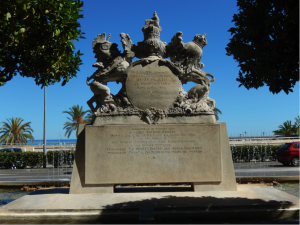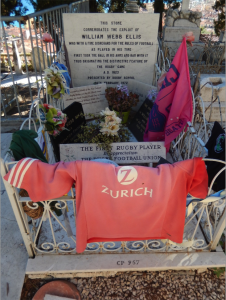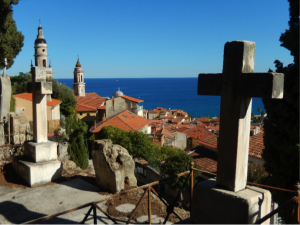On his travels again, Andrew Hillier finds evidence of British colonisation nearer home in the French Riviera resort of Menton.
In my last blog (Malaysian Linkages, Old and New) I examined how Britain’s presence in nineteenth-century Malaysia could be explored through its buildings, cemeteries and other spaces. Similar evidence of a British presence, albeit in a different context, can be found in Menton, the village, perched on an outcrop of the Mediterranean coast, which Britons began to frequent in the 1860s.
University of Bristol historian John Pemble’s, The Mediterranean Passion, published almost 30 years ago, remains the most engaging account of how the Riviera was colonised during this period, principally by Britons, Germans and Russians. As he shows, it was British doctors who, by ordering their patients to go south in winter, first transformed the region’s ‘humble French and Italian villages into fashionable winter resorts’.[1]
Nowhere was this process more evident than in Menton. If Dr James Henry Bennet (1816-1891) first put the medieval village on the English map, by recommending it for patients suffering from phthsis (tuberculosis), it was Queen Victoria who gave the resort its real impetus. She spent two months there in 1882, in search of a cure for her youngest son, the sickly Prince Leopold; sadly without success, as he died two years later.
Such was its attraction as a health resort that, by the turn of the century, invalids in ‘their Bath chairs monopolised the promenade du Midi by day and by night their premature retirement imparted a hospital hush to the atmosphere’.[2] By then, although multi-national, the French regarded it as ‘une colonie Britannique’. And although this was in part Gallic humour, it can properly be considered as part of ‘the British World’: of its seventy-five hotels, seventeen boasted Anglo-Saxon names, including Victoria, Windsor, Balmoral and Westminster, and, outside the old town, many of its Belle Ēpoque villas were owned or occupied by Britons, whose lush ‘English’ gardens cascaded down to the sea.
The more intimate setting of Le Cimetière du Vieux Chateau most obviously captures this presence. Multi-denominational, the marbled mausolea of French Roman Catholics greet you on arrival. Higher up the hill, the graves of those same invalids compete for the fabulous views which unfolded before the grieving mourners. Trusting in, but – alas – not cured by, treatments prescribed by Dr Bennet, they first started to be buried here in the 1870s. Plainer than the French graves, the simple stone slabs are each surrounded by a low gated fence – the only concession to the Mediterranean ambience. Evocative in their own right, they connect us with lives that, for all their luxury, ended, for many, in their early thirties.
It might be thought that these Britons, who spent their winters in Menton and other Riviera resorts, developed a more cosmopolitan outlook than their counterparts who stayed at home. The evidence is, however, against this. Most came in search only of the climate and a cure and had little interest in France or its culture, nor in associating with any of the other nationalities who wintered there. When they stayed in hotels, they held themselves aloof and when they rented villas, they brought their own servants to tend to their needs. If they had any interest in their surroundings, it was limited to classical antiquities. As Pemble concludes, in the years leading up to the First World War, the British ‘were never more insular than when they were abroad’.[3]
If this smacks of a typical colonial mentality, it would be wrong to suppose that it was resented then, or is so now. The resort is keen to celebrate what an official publication calls ‘la volonté Britannique de recréer un “bout d’Angleterre” partout où ils s’installent’.[4] Buildings and streets retain their English names: Rue Henry Bennett boasts a statue in his honour; Avenue Edouard VII runs in parallel to it; and, in 1960, an elegant fountain was installed in Square Victoria, as it is called, to commemorate the visit of that monarch’s mother.[5]
Not only is the foreign section of the cemetery well-maintained but public funds were also made available to restore the grave of a quintessential Englishman, even though he had not merited a mention in Pemble. If the Revd William Webb Ellis may not be the cemetery’s most celebrated incumbent, his grave is now certainly the most garlanded.
No indication is given as to why the Vicar of St Clement Danes, The Strand, was in Menton at the time, but, if, as seems likely, it was to convalesce, then as with so many others who came for that purpose, it was to no avail. A bachelor, he died on 24 January 1872 at the age of 65. Whether he did in fact pick up the ball and run and thereby found the game of rugby is controversial. However, plainly this does not trouble those who climb the hill to pay their respects and place their tributes on his tomb. Ranging from New Zealand to the Ukraine, they demonstrate how memorialisation can be a positive means of generating and reflecting international goodwill.
Surrounded by the graves of Britons, Russians, Germans and French, high above the bay known as Le Golfe de la Paix, the private memorial of one unassuming English clergyman provides a fitting space in which to ponder the fragile nature of international comity.
[1] John Pemble, The Mediterranean Passion: Victorians and Edwardians in the South (Oxford: Oxford University Press, 1988); quote at p.84.
[2] Pemble, p.87.
[3] Pemble, p.268.
[4] Francois Rosso et al., Menton rejoint la France: 1861, Chronique du Rattachement (Les Archives Municipales de Menton, 2011), p.58.
[5] The French always spell his name with two T’s, Pemble, following his BMJ entry, with one.





